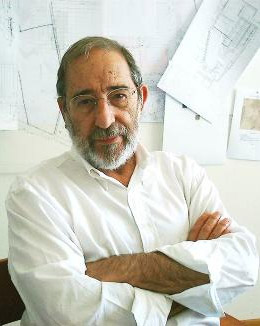
Royal Gold Medal 2009 was awarded to Álvaro Siza
 |
The President of The Royal Institute of British Architects (RIBA), Sunand Prasad, commented on the new award holder as follows: "Álvaro Siza is simply an architect who cannot be categorized in ordinary ways. The sculptural mastery and architecture seemingly belonging to the place from time immemorial may be one of the characteristics of Siza's work. The acquired facts about the place are manipulated into sculptural forms that are unusual or not predictably predictable, yet they never override typological clarity."
Siza's architecture matured in Portugal under the influence of dictatorship. However, it allowed for some communication with the international architectural scene. After studying, in 1955 he worked for three years with Fernando Távora, with whom he was perceived as a leading figure of the "Portuguese school." His approach to architecture is evident in his early independent projects - the charismatic Boa Nova Restaurant (1963), although decorated with a degree of decorative details, proves his interest in construction more than some of his later works.
After 1977 and the end of the dictatorship, Siza sought to design a large number of low-budget homes for the local government of Évora and later the National Association for Housing. He did not just want to design adaptable forms of housing but primarily to bring order to urban peripheries through them. This endeavor demonstrates Siza's relationship with larger urban scales. At the same time, during this period, Portugal opened up to the surrounding world, and Siza was soon invited to participate in competitions and projects abroad. For buildings in Germany, Spain, Italy, France, the Netherlands, and South Korea, Siza applied his unique approach. In London, he completed the pavilion for the Serpentine Gallery in collaboration with Eduardo Souto de Moura in 2006. At the same time, he continued to design inspiring houses in Portugal, such as the Training Center in Setúbal (1993), Faculty of Architecture of the University of Porto (1996), and the University campus in Aveiro (1995).
Despite the number of international projects, Álvaro Siza deliberately maintains a small circle of collaborators within the studio to have an overview of the ongoing work and to give proper attention to each project.
For the inspiring and admirable body of work he has produced over 40 years, and for his undeniable contribution to architecture through dialogue and educational activities, RIBA awarded its Royal Gold Medal for Architecture for 2009 to Álvaro Joaquim Melo Siza Vieira.
The article preparation used sources from www.riba.org and www.worldarchitecturenews.com
The English translation is powered by AI tool. Switch to Czech to view the original text source.
0 comments
add comment
Related articles
0
03.10.2020 | Royal Gold Medal 2021 was awarded to David Adjaye
0
26.01.2020 | Undisciplined Siza – exhibition at Serralves Museum
0
25.09.2015 | Royal Gold Medal 2016 was awarded to Zaha Hadid
0
27.09.2014 | Royal Gold Medal 2015 was awarded to O'Donnell + Tuomey
0
05.02.2013 | Royal Gold Medal 2013 was awarded to Peter Zumthor
0
14.12.2011 | <span style="font-weight:bold">Royal Gold Medal 2012 was awarded to Herman Hertzberger
0
12.10.2010 | Royal Gold Medal 2011 was awarded to David Chipperfield
0
05.10.2006 | Royal Gold Medal 2007 was awarded to Herzog and de Meuron
0
30.09.2005 | Royal Gold Medal 2006 was awarded to Toyo Ito










